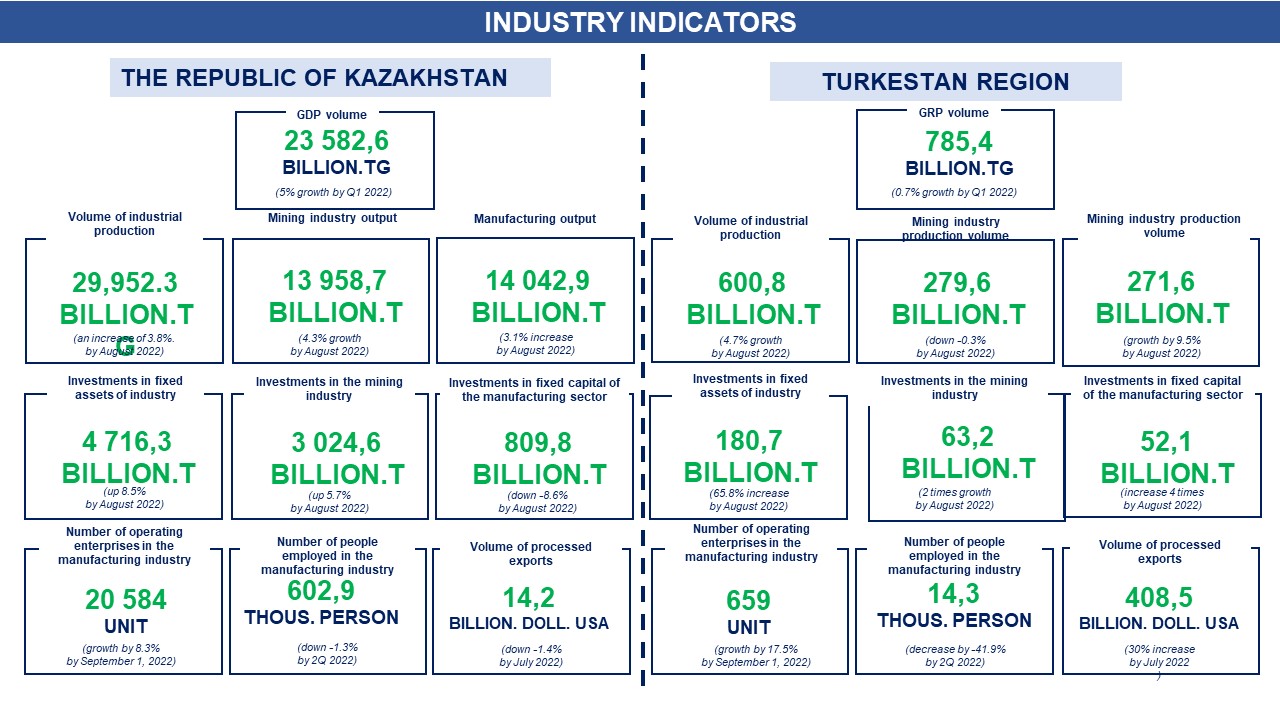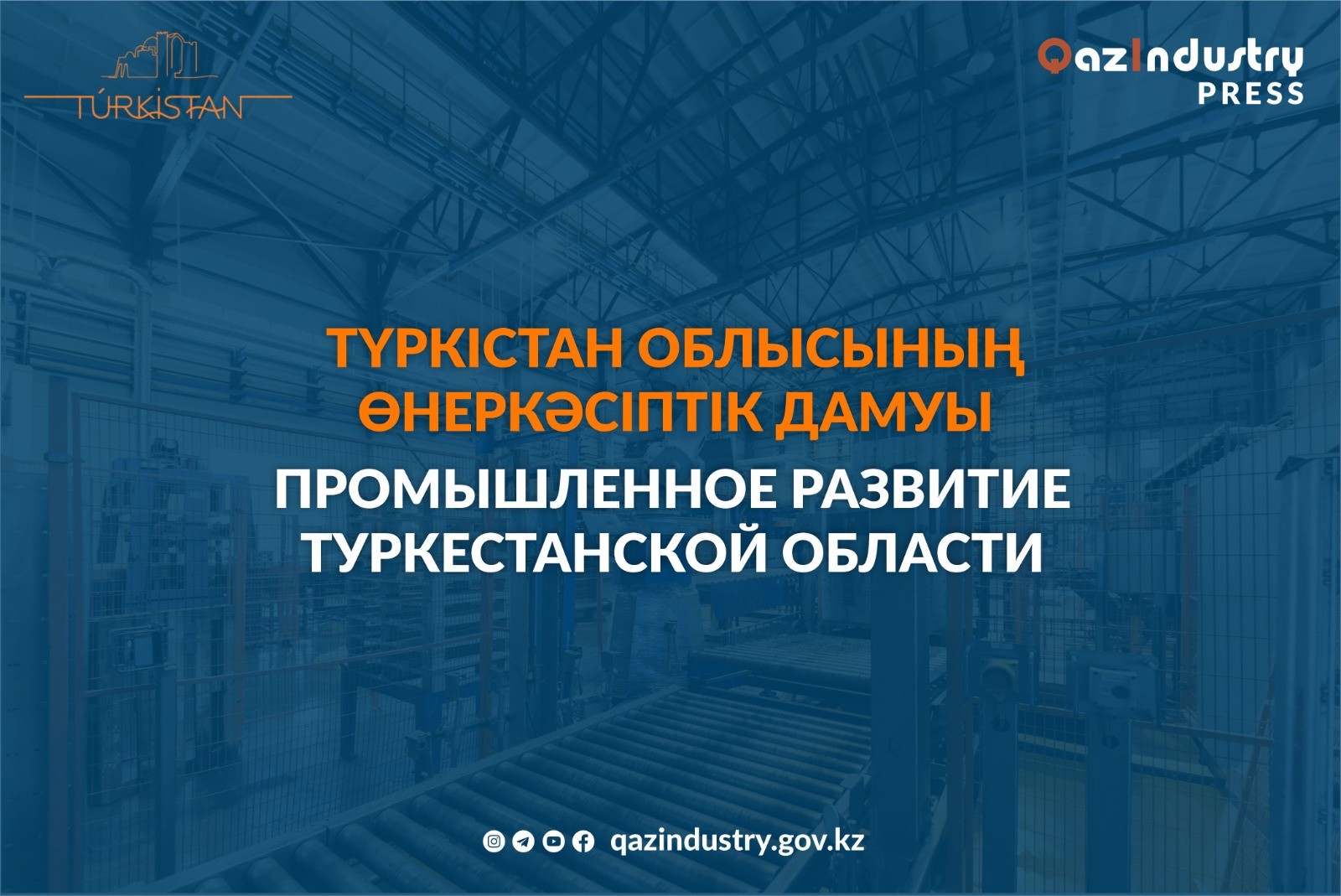Turkestan, located in the south of Kazakhstan, is one of the country's most industrialized and agricultural regions. There is significant potential for economic development and production in Turkestan. Among Kazakhstan's most labor-intensive regions, this is one of the most active.
As well as barite, coal, iron and polymetallic ores, vermiculite and talc, limestone, granite, marble, gypsum, quartz sands, limestone, granite and coal, the region is rich in mineral deposits. In Kazakhstan, the region ranks first in uranium reserves, third in phosphorites and iron ores.
Agriculture is of particular importance in the region. Here, cotton, corn, tobacco, sunflowers, fruits and vegetables are grown, leather raw materials are made, and astrakhan fur is tanned.
At the end of the 1st quarter of 2023, Turkestan was responsible for 3.3% of Kazakhstan's gross domestic product or 785.4 billion tenge, ranking 12th among its regions. Real estate transactions make up 18.4% of the region's GRP, followed by industry (17.2%), education (13.2%), agriculture, forestry and fisheries (10.5%) and transport and warehousing (9.2%).
In the industrial structure of the Republic of Kazakhstan for the period January-August 2023, the share of the Turkestan region was 2% or 600.8 billion tenge, an increase of 4.7% compared to the same period last year and ranked 17th in the country. The growth in the indicator is mainly associated with an increase in the production of manufacturing products, including light industry, production of other non-metallic mineral products, mechanical engineering, production of coke and refined petroleum products, as well as the supply of electricity, gas, steam, hot water and air conditioning.
Compared to the same period last year, the manufacturing industry's index of industrial production increased by 9.5% in January-August 2023. The mining industry and quarrying dominate the industrial structure, accounting for 46.5% (279.6 billion tenge). A total of 45.2% of the economy is derived from the manufacturing sector (271.6 billion tenges). As of January-August 2023, the region had the highest participation rate in the manufacturing sector in the production of precious and non-ferrous metals (32.6%), food products (29.4%), and mechanical engineering (10.8%).
Investments in fixed capital of industry in the region amounted to 180.7 billion tenge between January and August 2023, equivalent to 3.8% of the total volume in the country. Over the specified period, the Turkestan region invested 52.1 billion tenge in manufacturing, or 6.4% of the country's volume (6th place), which is four times higher than last year. Among the manufacturing industries, other non-metallic mineral products (40.9%), food products (12.6%), furniture (8.2%), and paper and paper products (8.1%) attracted the most investments.
A total of 659 enterprises operate in the manufacturing industry in Turkestan, including 624 small firms, 27 medium firms, and 8 large firms.
Turkestan is ranked third in the country in the production of 3 goods (parts for electric motors, generators, and transformers (KTZ JSC produces 99% of the country's production), natural uranium, and fish products).
Based on 7 months' results, Turkestan region commodity exports totaled 408.5 million US dollars in 2023, a 30% increase over 2022.
In the same period last year, imports totaled US$234.3 million, an increase of 20.2%.
The region's main external export partner is Russia, which accounted for 86.6% of the export basket of processed goods, mainly natural uranium and its compounds, alcohol tinctures obtained from distillation of grape wine or grape marc, food products, transformers with liquid dielectric with a power exceeding 650 kVA but not exceeding 10,000 kVA.
Approximately 33% of the Turkestan region's export basket of processed goods is imported from Russia, which is the region's primary foreign trade import partner. It consists primarily of wood and other lignified materials, such as wafers, that have been impregnated or not impregnated with resins or other organic binders to form particle boards, oriented strand boards (OSB), or similar boards. Also, the main import partners are Turkey (16.8%), which exports mostly joinery and carpentry products, wooden panels, assembled floor panels, roofing shingles and shingles, among others; Uzbekistan (16.5%) exported alcoholic liqueurs distilled from grape wine or grape marc; China (12.2%) exported polyvinyl chloride that has not been mixed with anything else.
Turkestan lies in a desert zone, bordering the Republic of Uzbekistan to the south. Due to the lack of statistics for the regions, the potential for industrial cooperation of the Turkestan region with the border territory of Uzbekistan was assessed for the country as a whole and indicated that cooperation occurred in mechanical engineering, metallurgy and metal finishing.
Considering the competitive capabilities of Uzbekistan, it is likely that in Kazakhstan, competition will increase in the automotive industry, chemicals, and light industry, particularly in passenger cars, polyethylene, and ready-made clothing.
Mechanical engineering, woodworking, food products, building materials, pharmaceuticals, especially for passenger cars, medicines, cement, furniture, etc., are some of the opportunities in Kazakhstan's industries.
In particular, cattle meat may be exported to Uzbekistan, including carcasses and half-carcasses, boneless cuts of bovine animals, fresh or chilled; cakes and other solid waste derived from the extraction of vegetable fats or oils from sunflower seeds, either unground or soil, nongranulated or granulated, except commodities. 2304 and 2305; transformers with liquid dielectric with a power of no more than 650kva; timber obtained by sawing or splitting lengthwise, planing or peeling, not processed or processed by planing, grinding, with or without end joints, with a thickness of more than 6 mm, coniferous: from pine; transformers with liquid dielectric with a power of more than 650 kVA, but not more than 10,000 kVA; particle board, oriented strand board (OSB) and similar boards (for example, wafer boards) of wood or other lignified materials, whether or not impregnated with resins or other organic binders; hulled rice (unpolished rice); frozen carp
In In general, the economy of Turkestan region is not highly concentrated, as compared to the Republic of Kazakhstan.
Manufacturing industries in the region may specialize in the production of fresh and canned fish, meat, fruits, dried fruit, sunflower seeds, whey, products made from natural milk components, electric motors, generators, and parts for them, zinc products, and ferrous metal products. As well as farming machinery, there is the potential for manufacturing baler presses for packing straw or hay into bales, as well as mowers, padlocks and mortise locks, as well as tires and tyres.
Comparative advantage (RCA) was determined based on indices of the complexity of Turkestan exports.






